The Caminho dos Faros, the “Walk of the Lighthouses”, is a newly established walk trail along the Galician coast in north-west Spain. BTF member and volunteer Christian Mau completed the 200km walk in June of 2019.
Walking the Camino Dos Faros
The trail links Malpica de Bergatinos with Finisterre and is marked by a series of lighthouses, prior to the construction of which many ships went aground on the reefs along this treacherous coastline, especially along the Costa del Morte, the Coast of Death. It is marked with a series of green arrows and is well trodden, making it relatively easy to follow.
There is ample accommodation along the way, which can be organised in advance, as can luggage transfer if desired. Food and drink is plentiful and for gourmets this is seafood heaven!
As with all walks, proper preparation will make the experience more enjoyable, so have good walking shoes to cope with the varying terrain and clothing to cope with the notoriously quick changing weather on the Atlantic coast. There are also many stretches with little shade from the sun, so plenty of sun tan cream is recommended.
The route is divided into eight sections, so be prepared to walk between 20km and 30km a day. Daylight hours in the summer are long, so nine to ten hours of steady walking each day, with plenty of breaks, is a comfortable pace.
This was Christian’s story, walking from east to west:
The trail starts with the smallest of the lighthouses at the port of Malpica, where I stocked up with drinks and snacks. It then passes through the town, along beautiful beaches to Cape St Adrian.

View from St Adrian back to Malpica
Further beach walking at Beo and Seiruga leads to a higher coastal walk leading to the lighthouse at Punta Nariga, the most modern of the lighthouses on the trail, which is approached by walking up through massive rock formations. From the lighthouse is a magnificent view of the rugged Atlantic coastline
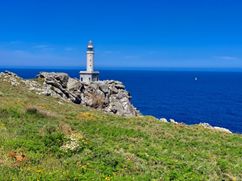
Lighthouse at Punta Nariga
The remainder of the day’s walk is over rocky outcrops to the picturesque Praia de Niñóns. The only accommodation close by is the Casa Vacacional Ninons-Ponteceso, which is 500m southwest of the beach.
The second stage involves a walk along beaches and cliff tops from Niñóns to the small town of Ponteceso, famous for its gooseneck barnacles (percebes), harvested from exposed sea cliffs by intrepid percebeiros. The first section took me via Porto Santa Mariña and Barda Beach to the Roncudo Lighthouse.
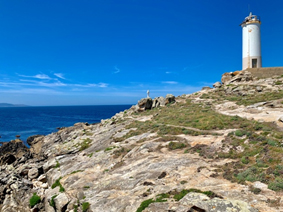
Roncudo Lighthouse
The name Roncudo has its origin in the Spanish word ronco, meaning hoarse—sound of the sea as it strikes the cliffs. There are breathtaking views of the estuary of Corme and Laxe from the cliff top. Down then to Porto de Corme, a beautiful fishing village, a climb to the cliffs of Monte da Facha and a descent into Ponteceso.
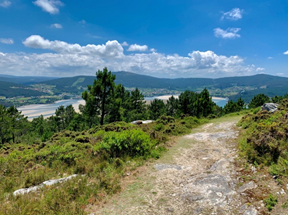
View from above the Estuary
On the third day the trail turned inland, initially through the Rego dos Muíños, three kilometres along the River Anllóns. I walked beside the river system, through the rain forest, past the remains of ancient water mills and channels. The lushness of this area made me forget how close I was to the coast. Initially I followed the river on a steep climb until turning towards the preserved remains of Castro A Cibda (a castle inhabited between the 6th and 7th century). There are lots of castros in this area. These settlements are in the high lands from where they dominate the whole area, and they are usually close to the bed of the rivers from which they took the water.
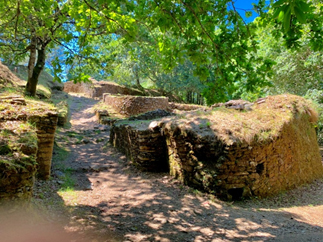
Castro A Cibda
From there I moved on to a second site of historic interest, the Dolmen de Dombate (a megalithic burial site, dating between 3000 and 2500 BC).
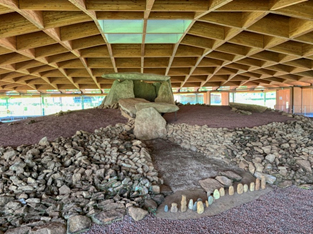
Dolmen de Dombate
Then it was back to the coast, uphill to the Monte Castelo de Lourida, with views of the beautiful beach at Laxe. I continued on through eucalyptus—imported from Australia—and pine forests to Costa Mundina, with views of the Anllóns estuary and the secluded beaches of Rebordelo and San Pedro. Then along Laxe Beach into the town, an excellent meal of fresh fried squid, a beer (or two) and a good night’s sleep at the Apartamentos de uso Touristico
The next section is the shortest of the eight at just 18km. The trail meanders along the cliffs to Monte da Insua and the Laxe Lighthouse. I reached the Laxe lighthouse and continued to Furna de Espuma, where sometimes on windy days the foam from the high ocean swell hits the rocks and clings onto the cliffs like snow.
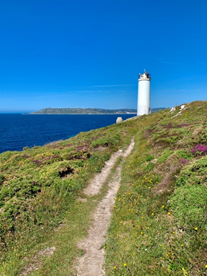
Laxe Lighthouse
From there the walk continues along windy beach of Traba, at the end of which I reached the small fishing village of Camelle and my destination, the village of Arou.
Stage five is follows the most treacherous part of the Costa del Morte between Arou and the beautiful port town of Camariñas, and is considered by many to be the highlight of the trail.
I headed out to the Lobeiras viewpoint via Xan Ferreiro’s cove, past long stretches of cliff rocks that reach out into the ocean and arrived at the isolated port of Santa Mariña. The village of Santa Mariña, which surrounds a Benedictine Monastery built in the 10th century, rests high above the port on a mountain ridge. Continuing to Monte Branco I gain a view of the Cementerio dos Ingleses, Cabo Vilan and lighthouse in the distance. The Cementerio dos Ingleses is the final resting place of sailors of the steamship Iris Hull and those of the Serpent, a British Crown ship. It is a sombre reminder of the dangers of this coastline and puts it into stark contrast the beauty that had experienced over the last few days.
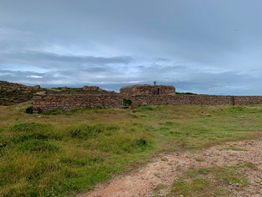
Cementerio dos Ingleses
Heading west towards Punta Boi and after a light climb via Monte Pedroso I arrived at the Cabo Vilan lighthouse, which is spectacularly set above the seemingly endless Atlantic Ocean. I stayed here until sunset and then walked into the beautifully lit town of Camariñas at 10pm.
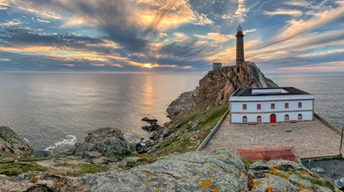
Cabo Vilan Lighthouse
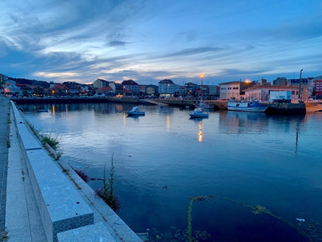
Camariñas
The sixth day of the walk from Camariñas to Muxia is 32km. This is a largely flat stretch, mostly following the estuary along beautiful protected beaches and coastal forest, with little villages and heritage buildings. At the small lighthouse of Playa de Lago I took a break and dipped my feet in the cool water, then continued across the river towards Muxia, largely through pine forests with a few paved road stretches.
As I entered the town centre I noticed many flower arrangements laid out in the streets, for the festival of San Juan that was taking place the next day to mark the summer solstice. After leaving my belongings at the Alberque Arribada I headed up the stone pathway to the top of Mt Corpiño to I enjoy the sunset over Muxia , the estuary and Cape Vilán, and decided to stay in Muxia an additional day to enjoy the festivities of San Juan.
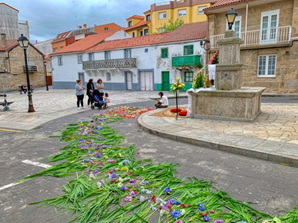
Flowers in Muxia for the Festival of San Juan
After an enjoyable and interesting day of festivities I arose early to tackle some challenging ascending and descending sections along the cliffs to Nemiña Beach.
The day starts with a stiff climb to the top of Mt. Cachelmo and then a series of switchback ups and downs to Moreira Beach and up to the lighthouse at Cape Touriñán, the westernmost point of the Camiño dos Faros and of Spain itself.
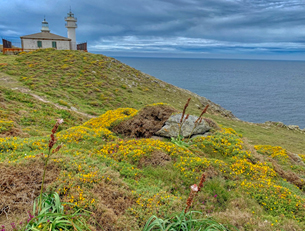
Cape Touriñán Lighthouse
After enjoying the views and a long rest, I walked the final four kilometres into the village of Talon and on to Nemiña beach. It had been a physically challenging day and after arriving at the Hotel Rural Fontequeiro I fell asleep on my bed—before dinner!
Day eight, my last day—the final stage from Nemiña Beach to Cape Finisterre. Finisterre comes from the Latin “finis terrae” as the Romans believed it was at the end of the known world. I crossed the channel of the River Lires and followed more beautiful cliffs and beaches, the beaches always being most challenging. At Punta Castelo I have a good rest at the ruins of Iron Age castle of Castrominan, then head along rugged coastline paths to the Cabo de la Nave, from where I had a view of Mar de Fora beach on the northern side of Finisterre, and the final lighthouse on the walk at Cape Finisterre.
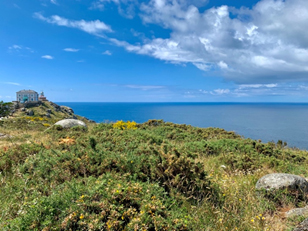
Lighthouse at Cape Finisterre
Finally, I walked down to the beach and into town to the Albergue Finistellae, where I met again the owner, the man who introduced me to the walk and who was happy to see me again. I had completed the Camino dos Faros and it was wonderful—”Muchas Gracias!”
For those interested in the Camino dos Faros please go to their excellent website: http://www.caminodosfaros.com/
